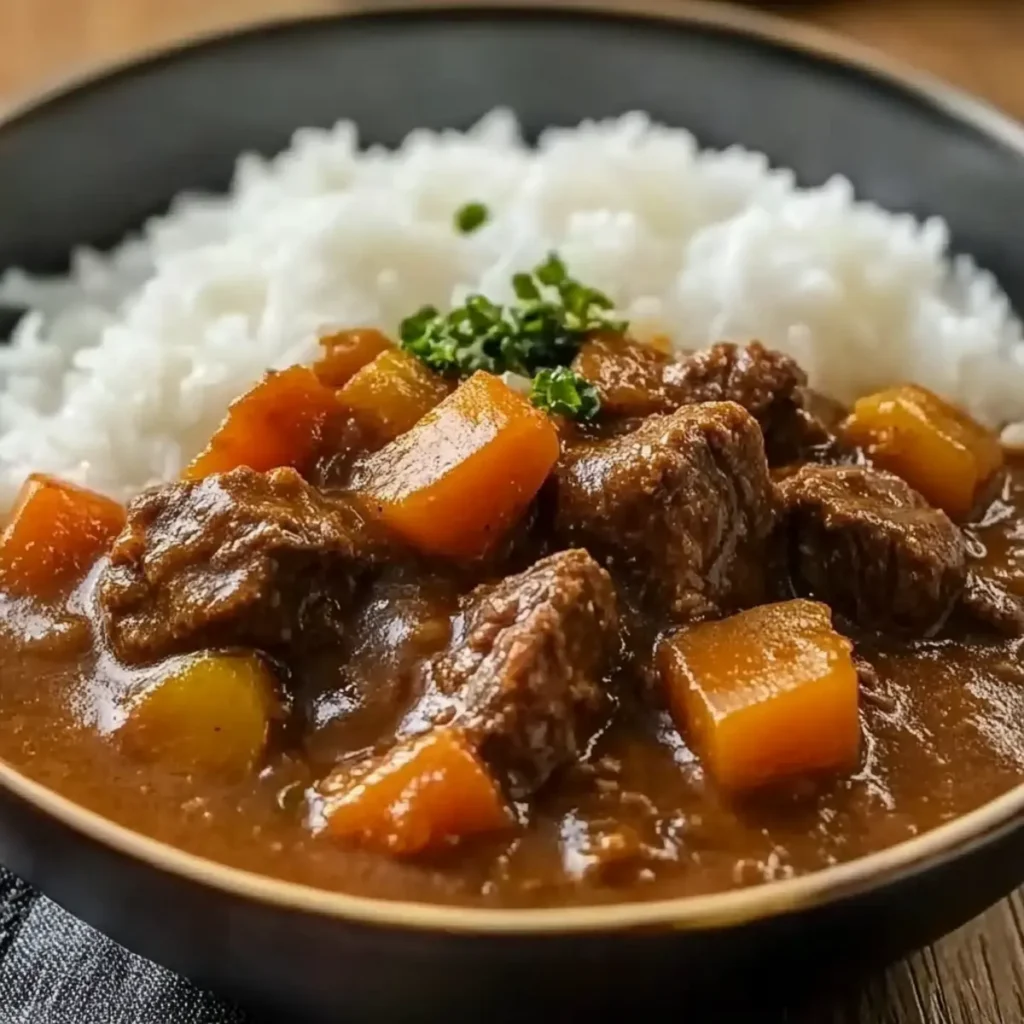The enticing aroma of simmering broth fills the kitchen, transporting me straight to a cozy German bistro. As the clouds gather outside, there’s nothing quite like a bowl of traditional German soup to warm the soul. With recipes like the creamy Kartoffelsuppe and the robust Gulaschsuppe, these comforting dishes are perfect for any occasion, from family gatherings to quiet evenings. The best part? They are not only hearty but also versatile—many versions are gluten-free and packed with nourishing ingredients. Each spoonful not only satisfies hunger but also creates a delightful culinary experience that invites you to savor each moment. Ready to dive into the world of German soup and discover your new favorite? Let’s get cooking!
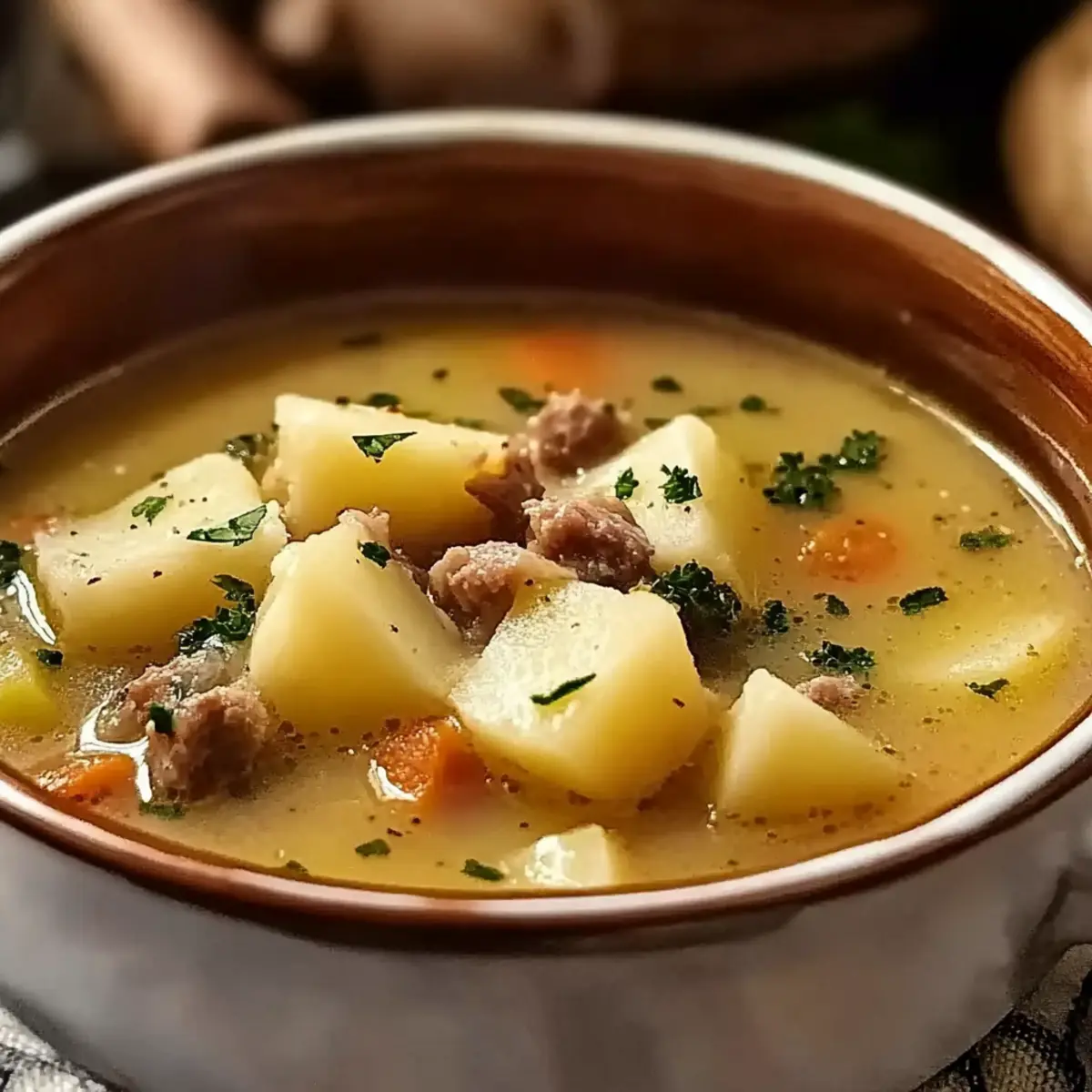
Why is German Soup so beloved?
Warmth and Comfort: Each bowl of German soup is like a hug in a bowl, perfect for chilly nights or comforting family gatherings.
Versatile Ingredients: With options like Kartoffelsuppe and Gulaschsuppe, you can enjoy a variety of flavors while customizing to suit dietary preferences, like gluten-free substitutions.
Quick and Easy: The straightforward cooking process saves you time, making it a go-to for busy weeknights.
Crowd-Pleasing Flavors: Rich, hearty profiles ensure your guests will rave about the meal, making it a great choice for gatherings.
Healthy and Hearty: Packed with nutritious vegetables and proteins, these soups provide essential vitamins and minerals while still being indulgently delicious.
Create Memories: As you enjoy these comforting recipes, you’ll be evoking warm memories of shared meals and family traditions, making every bite special.
For more comforting options, don’t miss our Cowboy Soup Hearty and Chicken Tortilla Soup recipes!
German Soup Ingredients
• Get ready to create tantalizing bowls of comfort with these essential ingredients!
For the Kartoffelsuppe
- Potatoes – they provide the creamy base essential for a comforting texture. For a lower-carb option, substitute with cauliflower.
- Vegetable Broth – deepens the flavor; homemade enhances richness while low-sodium store-bought offers convenience.
- Carrots – add natural sweetness and brighten the dish; parsnips can make a delicious alternative.
- Onions – create a savory foundation, and shallots are a lovely milder substitute.
For the Gulaschsuppe
- Sausage (smoked or fresh) – brings protein and richness to this hearty soup; feel free to swap with lentils for a vegetarian delight.
- Paprika – adds a signature warmth and character; smoked paprika can elevate the flavor profile.
- Red Bell Peppers – contribute sweetness and vibrant color; substitute with any preferred bell pepper variety.
For a Rich Finish
- Cream – grants a luscious richness to the Kartoffelsuppe; omit or swap with an extra splash of broth for a lighter version.
- Herbs (like parsley or dill) – brighten the flavor and add freshness; fresh herbs are highly recommended, but dried versions work too.
In this cozy German soup journey, each ingredient sings harmoniously, creating a symphony of flavor in every bowl!
Step‑by‑Step Instructions for German Soup
Step 1: Prep Vegetables
Begin your German soup adventure by washing, peeling, and chopping 4 medium potatoes, 2 carrots, and 1 onion. Aim for uniform pieces to ensure even cooking. Set your prepared veggies aside in a bowl, where their vibrant colors will inspire your cooking process as you gather the rest of your kitchen tools.
Step 2: Sauté Aromatics
In a large pot, heat 2 tablespoons of vegetable oil over medium heat. Once the oil shimmers, add the chopped onions and sauté them for about 5 minutes until they become translucent and fragrant. Stir occasionally to prevent sticking, allowing the aromatic base to form the heart of your comforting German soup.
Step 3: Add Vegetables
Once the onions are translucent, stir in the chopped potatoes and carrots, cooking them for an additional 3-4 minutes. You’ll want to see them soften slightly, releasing their sweetness while absorbing the savory aroma from the sautéed onions. This step enhances the flavor depth, making your German soup truly inviting.
Step 4: Add Broth and Protein
Pour in 6 cups of vegetable broth, ensuring the vegetables are fully submerged. If using sausage, slice 1 cup of your choice (smoked or fresh) and add it to the pot. Stir well and bring the mixture to a boil over high heat. The anticipation of those bubbling flavors makes this step exciting, as your kitchen fills with a warming aroma.
Step 5: Simmer
Reduce the heat to low, cover the pot, and let your German soup simmer for 20-30 minutes. This gentle cooking allows the vegetables to become tender and the flavors to meld harmoniously. You’ll know it’s ready when the potatoes are fork-tender and inviting, creating a deliciously rich broth.
Step 6: Blend (if desired)
For a creamy texture in your Kartoffelsuppe, use an immersion blender to puree the soup until it reaches your desired consistency. Blend for about 1-2 minutes and see how the colors transform into a velvety finish. If you prefer a chunkier soup, skip this step and embrace the hearty texture of your German soup.
Step 7: Finish with Cream
Stir in 1/2 cup of heavy cream just before serving, bringing a luxurious richness to your soup. Allow it to warm through for a couple of minutes, stirring gently. Taste and adjust seasonings with salt and pepper to elevate the flavor profile of your comforting German soup.
Step 8: Serve
Ladle the steaming German soup into bowls, garnishing with fresh herbs like parsley or dill for a pop of color. Serve hot alongside crusty bread or soft pretzels. As you enjoy this heartwarming dish, relish the warmth it brings to your cozy nights, reminding you of cherished family gatherings.
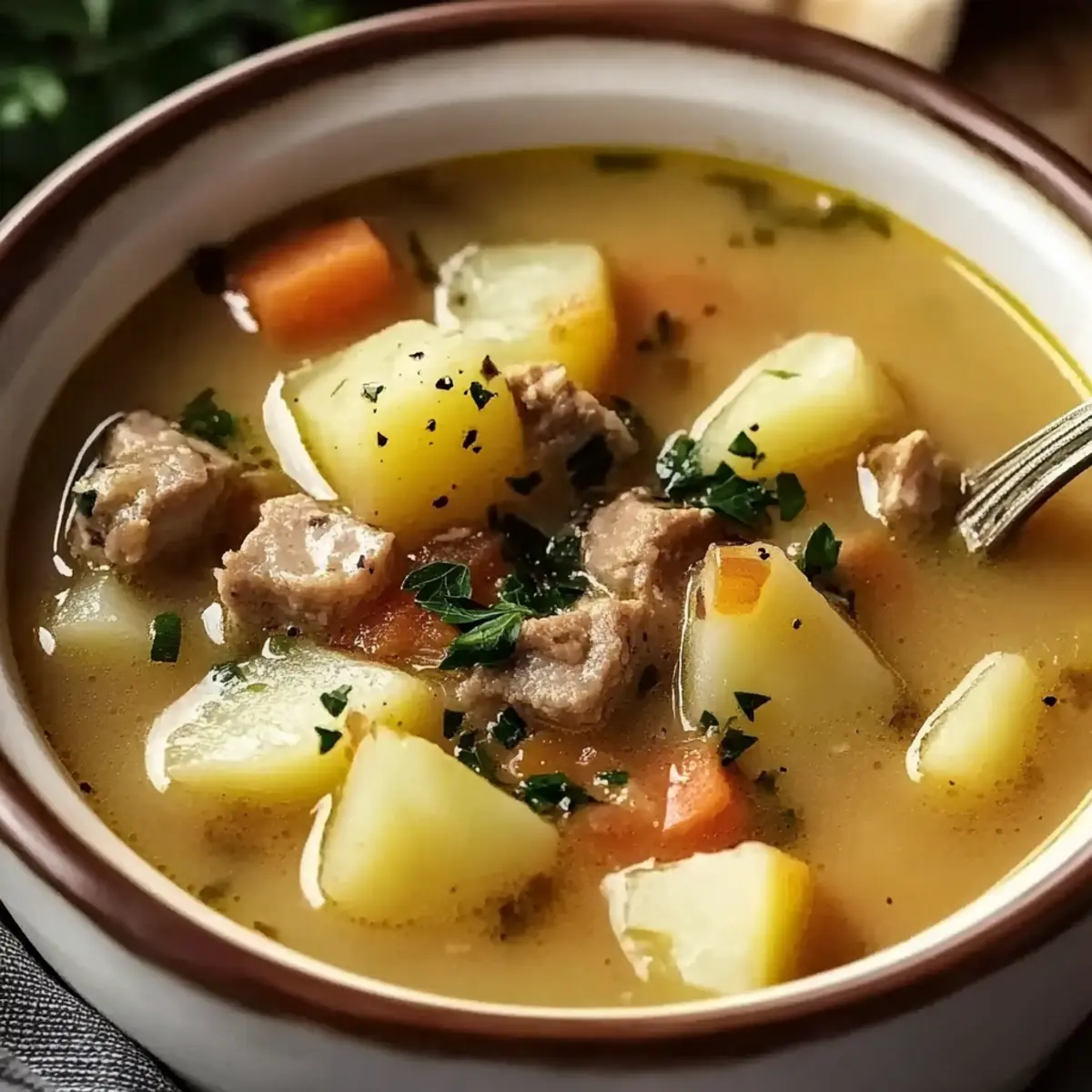
Make Ahead Options
Preparing traditional German soup in advance is a fantastic way to save time on busy weeknights! You can chop the potatoes, carrots, and onions up to 24 hours ahead; simply store them in an airtight container in the fridge to preserve their freshness. Additionally, you can cook the soup base (steps 1 to 5) and refrigerate it for up to 3 days. When you’re ready to enjoy your hearty German soup, just reheat on the stove and stir in the heavy cream before serving. This method ensures that every bowl remains just as delicious and comforting, while also giving you more time to relish the cozy moments around the dinner table.
Expert Tips for German Soup
-
Timing Is Key: Use a timer to ensure vegetables are perfectly tender but not mushy. It helps maintain the texture and flavor profile of your German soup.
-
Thickening Made Easy: If you prefer a thicker soup, let it simmer longer to evaporate excess liquid. Alternatively, blend a portion for added creaminess.
-
Flavor Variations: If using mild sausage, enhance flavor with smoked paprika or extra seasonings to achieve that robust taste in your Gulaschsuppe.
-
Fresh vs. Dried Herbs: Fresh herbs like parsley or dill can significantly brighten your soup’s flavor. If using dried, adjust quantities accordingly for the best results.
-
Ingredient Swaps: Don’t hesitate to experiment! Use sweet potatoes for a different twist or add leafy greens for extra nutrients.
-
Storage Savvy: Store leftovers in airtight containers for up to 3 days in the fridge, and freeze for up to 3 months. Reheat gently, adding a splash of broth if needed.
Storage Tips for German Soup
Fridge: Store your leftover German soup in airtight containers for up to 3 days. Make sure to let it cool completely before sealing to prevent condensation.
Freezer: For longer storage, freeze your soup in portions for up to 3 months. Use freezer-safe bags or containers, leaving some space for expansion as it freezes.
Reheating: When ready to enjoy, reheat on the stove over medium heat until warmed through. Add a splash of broth to restore creaminess if needed.
What to Serve with German Soup
Indulging in a warm bowl of German soup is just the beginning of a cozy dining experience; let’s elevate it with delightful sides!
-
Crusty Multigrain Bread: Perfect for soaking up the rich broth, this hearty bread adds satisfying texture and nuttiness to your meal.
-
Soft Pretzels: These iconic German snacks bring a delightfully chewy element, making them a fun dipper for your soup and adding a festive touch.
-
Crisp Green Salad: Fresh greens and a tangy vinaigrette provide a refreshing contrast, balancing the warmth and richness of the soup beautifully.
-
Pickled Vegetables: The tangy crunch of pickles or sauerkraut gives a wonderful zing, helping to cleanse the palate between bites of hearty soup.
-
Spiced Apple Cider: A warm cup of this comforting beverage complements the flavors of the soup, wrapping you in cozy fall vibes.
-
Black Forest Cake: End your meal on a sweet note with this famous dessert, whose rich chocolate and cherry layers create a perfect contrast to the savory soup.
Embrace the flavors and textures that accompany your German soup, transforming dinner into a warm and nourishing experience!
German Soup Variations & Substitutions
Feel free to switch things up and tune this German soup recipe to your taste—there are so many delightful possibilities!
- Sweet Potato Swap: Replace traditional potatoes with sweet potatoes for a hint of sweetness that lingers on the palate.
- Leafy Greens Addition: Add kale or spinach to boost nutrition and color. These greens will give your soup a fresh flair and vibrant appearance.
- Vegan Version: Omit all animal products and use lentils or chickpeas as a hearty substitute for sausage, ensuring a protein-rich bowl.
- Cauliflower Base: For a lighter take, mash cauliflower instead of potatoes for your Kartoffelsuppe, maintaining creaminess with fewer carbs.
- Dairy-Free Delight: Use coconut milk or almond cream in place of heavy cream for a luscious finish without dairy. Your soup will adopt a unique flavor profile!
- Heat It Up: Want a kick? Add a dash of cayenne pepper or red chili flakes to your Gulaschsuppe for that perfect spicy warmth that lingers.
- Herb Variety: Experiment with different herbs such as thyme or rosemary for a fragrant twist. Fresh versus dried can dramatically influence the flavor!
- Smoked Paprika Boost: Elevate the overall taste by adding a touch of smoked paprika for a deeper, richer flavor profile in your Gulaschsuppe.
These variations make it even more fun to explore the world of German soup! For more heartwarming recipes, try our Busy Day Soup or savor the tangy goodness of Dill Pickle Soup.
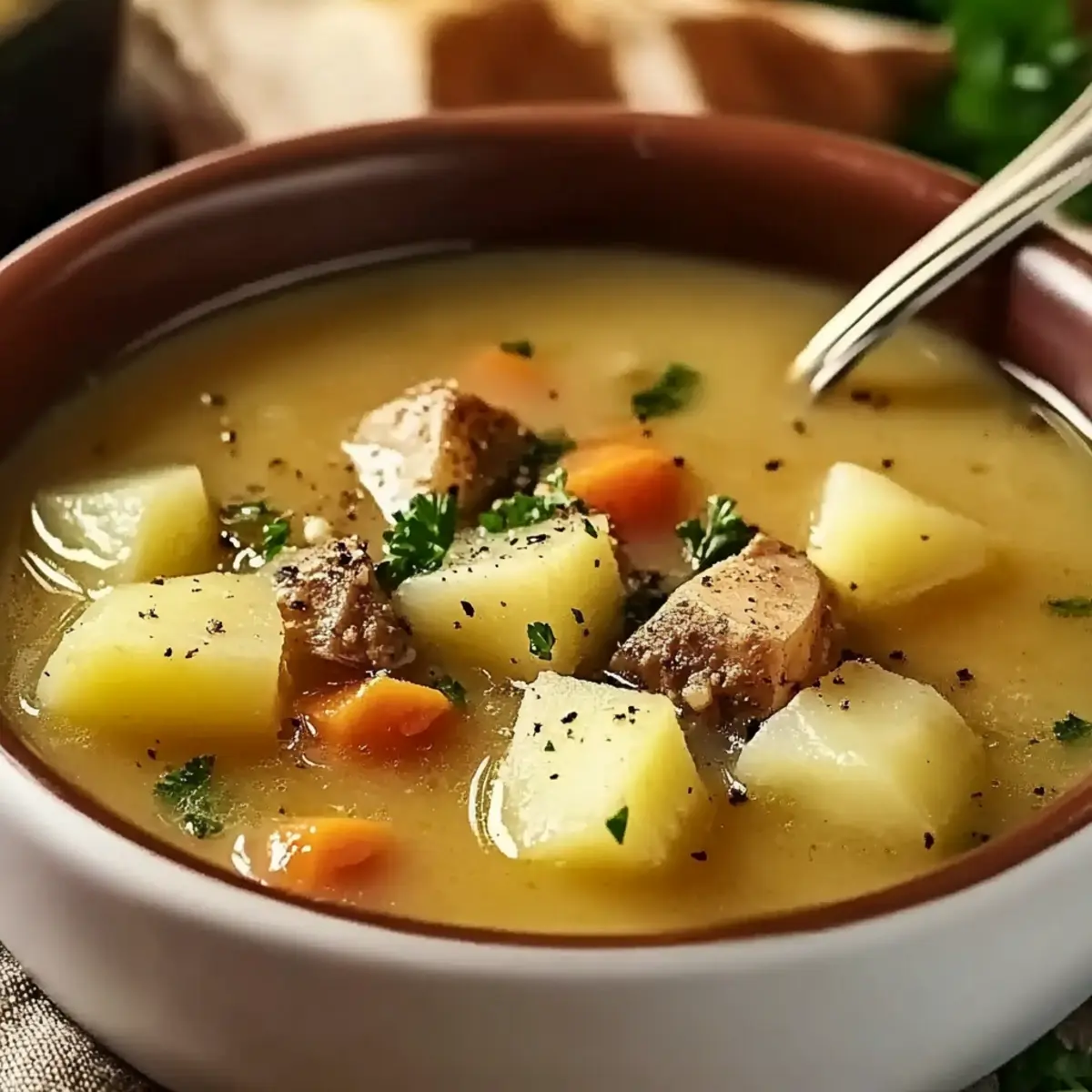
German Soup Recipe FAQs
What type of potatoes are best for Kartoffelsuppe?
For the creamiest Kartoffelsuppe, I recommend using starchy potatoes like Russets or Yukon Golds. These types break down beautifully when cooked, lending that luscious, rich texture to your soup. Avoid waxy potatoes, as they hold their shape and can result in a less creamy finish.
How should I store leftover German soup?
Absolutely! Store your leftover German soup in airtight containers in the fridge for up to 3 days. Make sure it cools completely before sealing to avoid condensation. For longer storage, freeze the soup in portions using freezer-safe bags or containers for up to 3 months.
Can I freeze German soup?
Yes, you can! To freeze your German soup, let it cool first and then portion it into airtight containers or freezer bags, leaving some space for expansion. When you’re ready to enjoy, simply reheat on the stove over medium heat. If the soup has thickened, add a splash of broth to regain that creamy texture!
What if my soup is too thick?
If your German soup turns out too thick for your liking, don’t worry! Just stir in a little vegetable broth or water until you reach your desired consistency. Heat it gently and taste to adjust the seasoning if necessary. The more the merrier when it comes to flavor!
Are there any gluten-free options for this German soup?
For sure! You can make your German soup gluten-free by using gluten-free sausage and ensuring your vegetable broth is free of gluten. Many brands offer delicious gluten-free alternatives that work seamlessly in these recipes. Always check ingredient labels for peace of mind!
Can I use frozen vegetables instead of fresh?
Definitely! Using frozen vegetables can save time and is a very convenient alternative. They are often frozen at peak freshness and can make cooking even simpler. Just adjust cooking times slightly; you may need less simmering to achieve the same tender texture. Enjoy the simplicity!
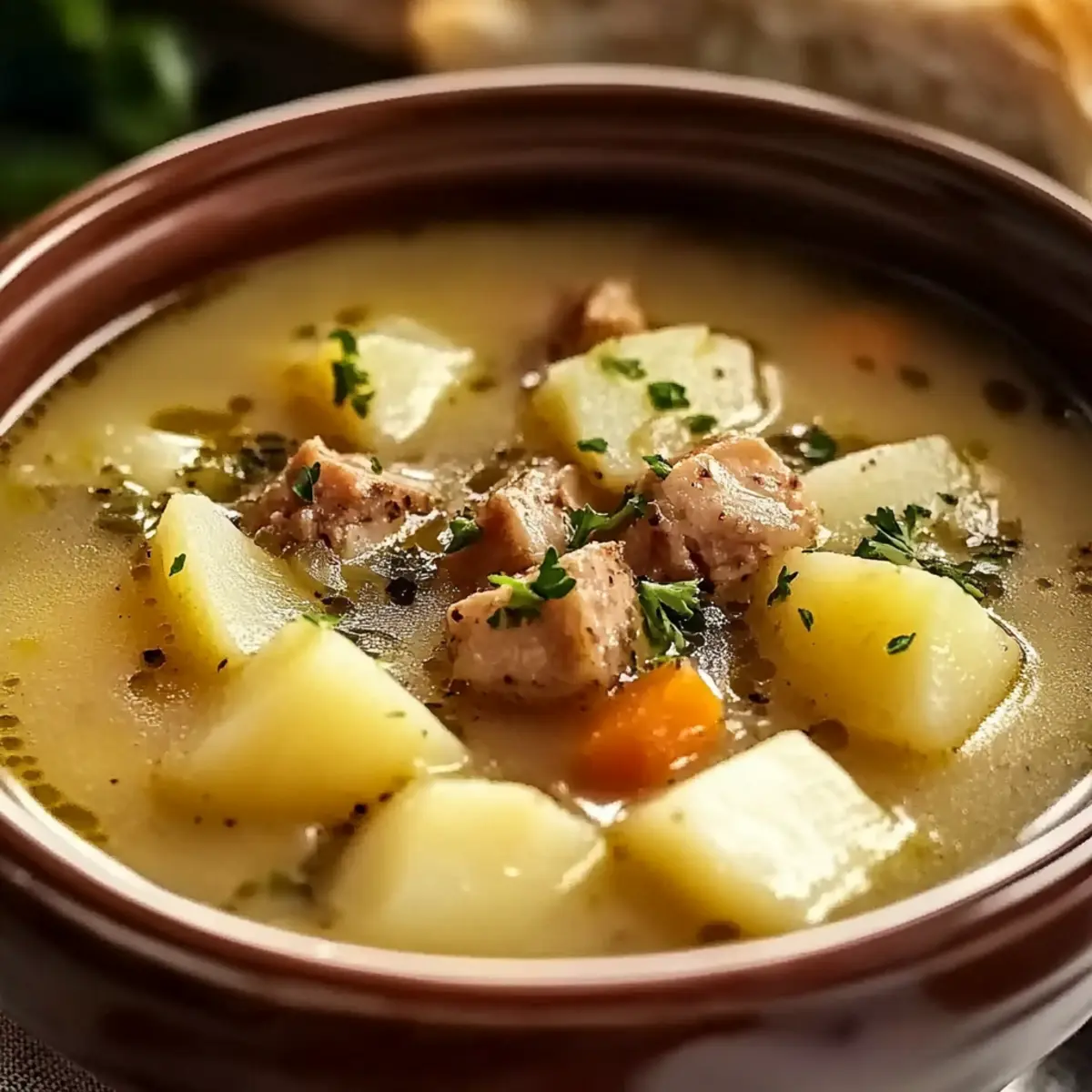
German Soup: Heartwarming Comfort for Your Cozy Nights
Ingredients
Equipment
Method
- Begin your German soup adventure by washing, peeling, and chopping the potatoes, carrots, and onion. Aim for uniform pieces to ensure even cooking. Set your prepared veggies aside in a bowl.
- In a large pot, heat the vegetable oil over medium heat. Once the oil shimmers, add the chopped onions and sauté them for about 5 minutes until they become translucent and fragrant.
- Once the onions are translucent, stir in the chopped potatoes and carrots, cooking them for an additional 3-4 minutes.
- Pour in the vegetable broth, ensuring the vegetables are fully submerged. If using sausage, slice and add it to the pot. Stir and bring the mixture to a boil over high heat.
- Reduce the heat to low, cover the pot, and let your soup simmer for 20-30 minutes until the potatoes are fork-tender.
- For a creamy texture, use an immersion blender to puree the soup until it reaches your desired consistency.
- Stir in the heavy cream just before serving, bringing a luxurious richness to your soup. Adjust seasonings with salt and pepper.
- Ladle the steaming soup into bowls, garnishing with fresh herbs. Serve hot alongside crusty bread or soft pretzels.



